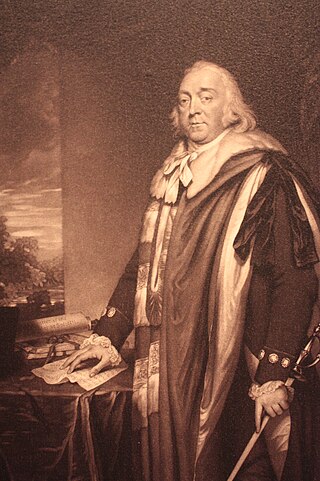| Earl of Romney 2nd creation | |
|---|---|
  Arms of Marsham: Argent, a Lion passant Gules, between two Bendlets Azure. Crest: A Lion's Head erased Gules. Supporters: On either side a Lion Azure, semée of Crosses-Crosslet Or, gorged with a Naval Crown Or. | |
| Creation date | 22 June 1801 |
| Creation | Second |
| Created by | King George III |
| Peerage | Peerage of the United Kingdom |
| First holder | Charles Marsham, 1st Earl of Romney |
| Present holder | Julian Marsham, 8th Earl of Romney |
| Heir apparent | David Marsham, Viscount Marsham |
| Subsidiary titles | Viscount Marsham Baron Romney Baronet 'of Cuchston' |
| Status | Extant |
| Seat(s) | Gayton Hall |
| Former seat(s) | Mote House |
| Motto | NON SIBI SED PATRIÆ (For country not self) |
| Earl of Romney 1st creation | |
|---|---|
  Arms of Sydney: Or, a Pheon Azure, a Crescent for difference. Crest: A Porcupine Azure, quilled, collared and chained Or, a Crescent for difference. Supporters: Dexter: A Lion Azure, collared and chained Or, ducally crowned per pale Argent and Gules, a Crescent for difference; Sinister: A Lion guardant Argent, ducally crowned Or, a Crescent for difference. | |
| Creation date | 8 April 1694 |
| Creation | First |
| Created by | William III and Mary II |
| Peerage | Peerage of England |
| First holder | Henry Sydney, 1st Earl of Romney |
| Last holder | Henry Sydney, 1st Earl of Romney |
| Subsidiary titles | Viscount Sydney Baron Milton |
| Status | Extinct |
| Extinction date | 8 April 1704 |
| Motto | QUO FATA VOCANT (Whither the Fates call / Where destiny calls) |
Earl of Romney (pronounced "Rumney") is a title that has been created twice.
Contents
- Earls of Romney, first creation
- Viscounts Sydney (1689)
- Earls of Romney (1694)
- Earls of Romney, second creation
- Marsham baronets, of Cuckston (1663)
- Barons Romney (1716)
- Earls of Romney (1801)
- See also
- References
- Further reading
- External links
It was first created in the Peerage of England in 1694 in favour of the soldier and politician Henry Sydney. He had been made Baron Milton and Viscount Sydney at the same time in 1689. [1] Sydney was the younger son of Robert Sydney, 2nd Earl of Leicester. He never married and the titles became extinct on his death in 1704.
It was created for the second time in the Peerage of the United Kingdom in 1801 in favour of Charles Marsham, 3rd Baron Romney. The Marsham family descends from Sir John Marsham, one of the six Clerks of the Court of Chancery from 1638 to 1644 and from 1660 to 1680. In August 1663 he was created a Baronet, of Cuckston in the County of Kent, in the Baronetage of England. [2] His grandson, the fourth Baronet (who succeeded his nephew), was also a Clerk of the Court of Chancery and represented Maidstone in the House of Commons. His son, the fifth Baronet, also sat as Member of Parliament for Maidstone and served as Governor of Dover Castle. In 1716 he was raised to the Peerage of Great Britain as Baron of Romney, of Romney in the County of Kent. [3]
His grandson, the aforementioned third Baron, represented Maidstone and Kent in Parliament and served as Lord Lieutenant of Kent. In 1801 he was created Viscount Marsham, of The Mote in the County of Kent, and Earl of Romney, in the Peerage of the United Kingdom. [4] He was succeeded by his son, the second Earl. He was Member of Parliament for Hythe and Downton. His son, the third Earl, represented Kent West in the House of Commons. He was succeeded by his son, the fourth Earl, who held political office in the second Conservative government of Lord Salisbury as a Lord-in-waiting (government whip in the House of Lords) from 1889 to 1892.
The line of his eldest son, the fifth Earl, failed on the death of the latter's son, the sixth Earl, in 1975. The late Earl was succeeded by his first cousin, the seventh Earl. He was the son of Lieutenant-Colonel Reginald Hastings Marsham, second son of the fourth Earl. As of 2010 [update] the titles are held by his first cousin once removed, the eighth Earl, who succeeded in 2004. He is the son of Colonel Peter William Marsham, son of Sydney Edward Marsham, youngest son of the fourth Earl.
The family seat was at Mote House, near Maidstone, Kent, but since 1891 it has been the Gayton Hall Estate at Gayton near Kings Lynn, Norfolk.












